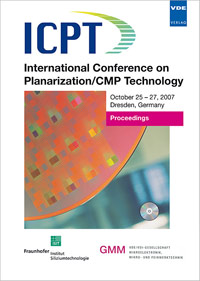Applications of Shear Force Spectral Analysis in STI CMP
Konferenz: ICPT 2007 - International Conference on Planarization / CMP Technology
25.10.2007 - 27.10.2007 in Dresden, Germany
Tagungsband: ICPT 2007
Seiten: 5Sprache: EnglischTyp: PDF
Persönliche VDE-Mitglieder erhalten auf diesen Artikel 10% Rabatt
Autoren:
Sampurno, Y.; Sudargho, F.; Zhuang, Y.; Philipossian, A. (Dept. of Chemical and Env. Engineering, University of Arizona, Tucson, Arizona, USA)
Sudargho, F.; Zhuang, Y.; Philipossian, A. (Araca, Inc., Tucson, Arizona, USA)
Ashizawa, T.; Morishima, H. (Hitachi Chemical Co., Ltd., Tokyo, Japan)
Inhalt:
This study explores the transition of shear force spectral fingerprint during STI CMP using an APD-500 polisher capable of simultaneously measuring real-time shear force and down force at high frequencies. Fast Fourier Transformation is performed to convert the shear force data from time domain to frequency domain and to illustrate the amplitude distribution of the shear force. Such frequency spectra give in-depth insight into interactions among abrasive particles, the pad and the wafer. First, the effect of different ceria particle size on coefficient of friction (COF) and removal rate is studied using 200-mm blanket PETEOS wafers. COF and removal rate are found to both increase with particle size, with saturation observed at the largest particle size studied. Secondly, STI patterned wafers are over-polished using one of the above cerium oxide slurries. Results show that shear force increases during polishing when the HDP oxide layer is removed thus exposing the Si3N4 layer. At the same time, variance of shear force is reduced. Unique and consistent spectral fingerprints are generated showing significant changes in several fundamental peaks before, during, and after transition to silicon nitride polishing. It is believed that such spectral fingerprinting can be used to monitor the STI polishing process in real-time.


